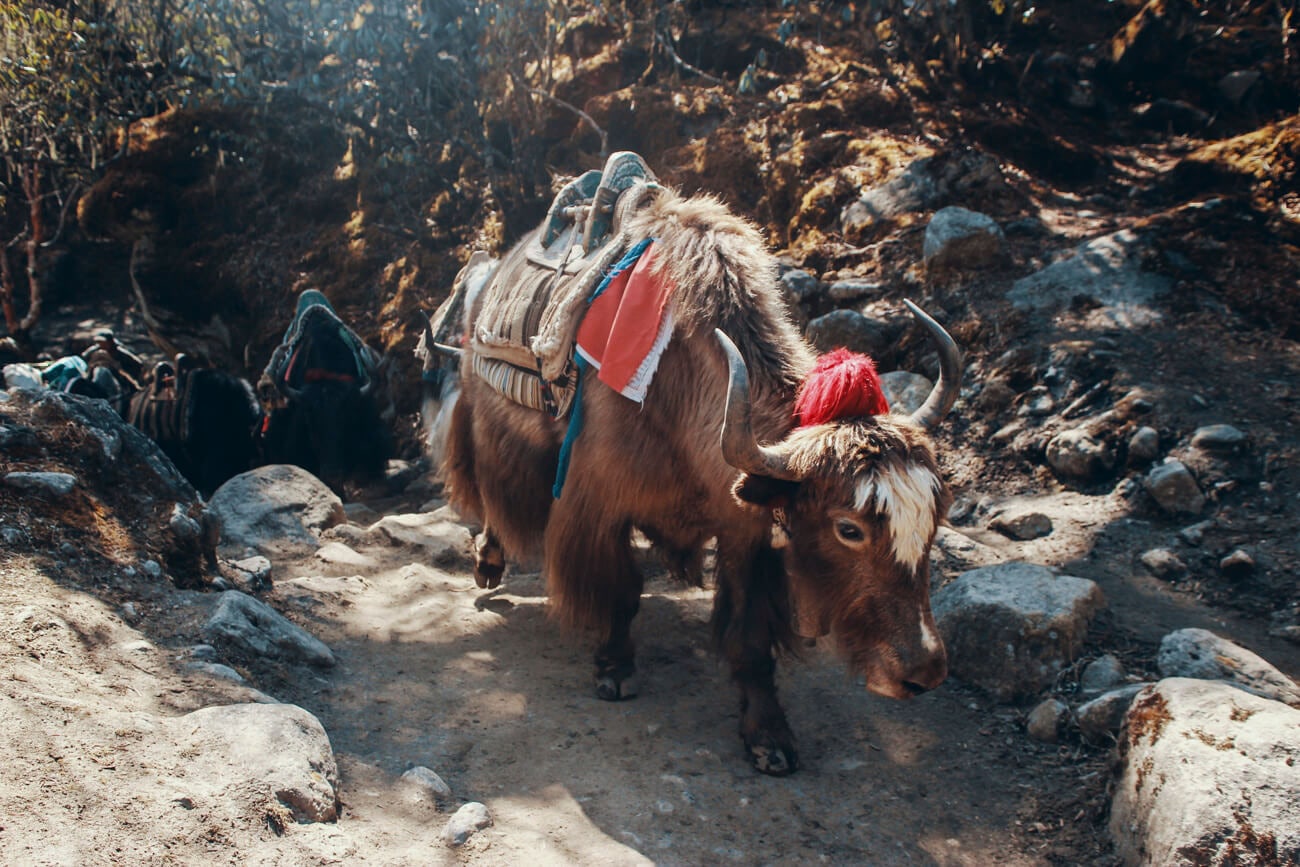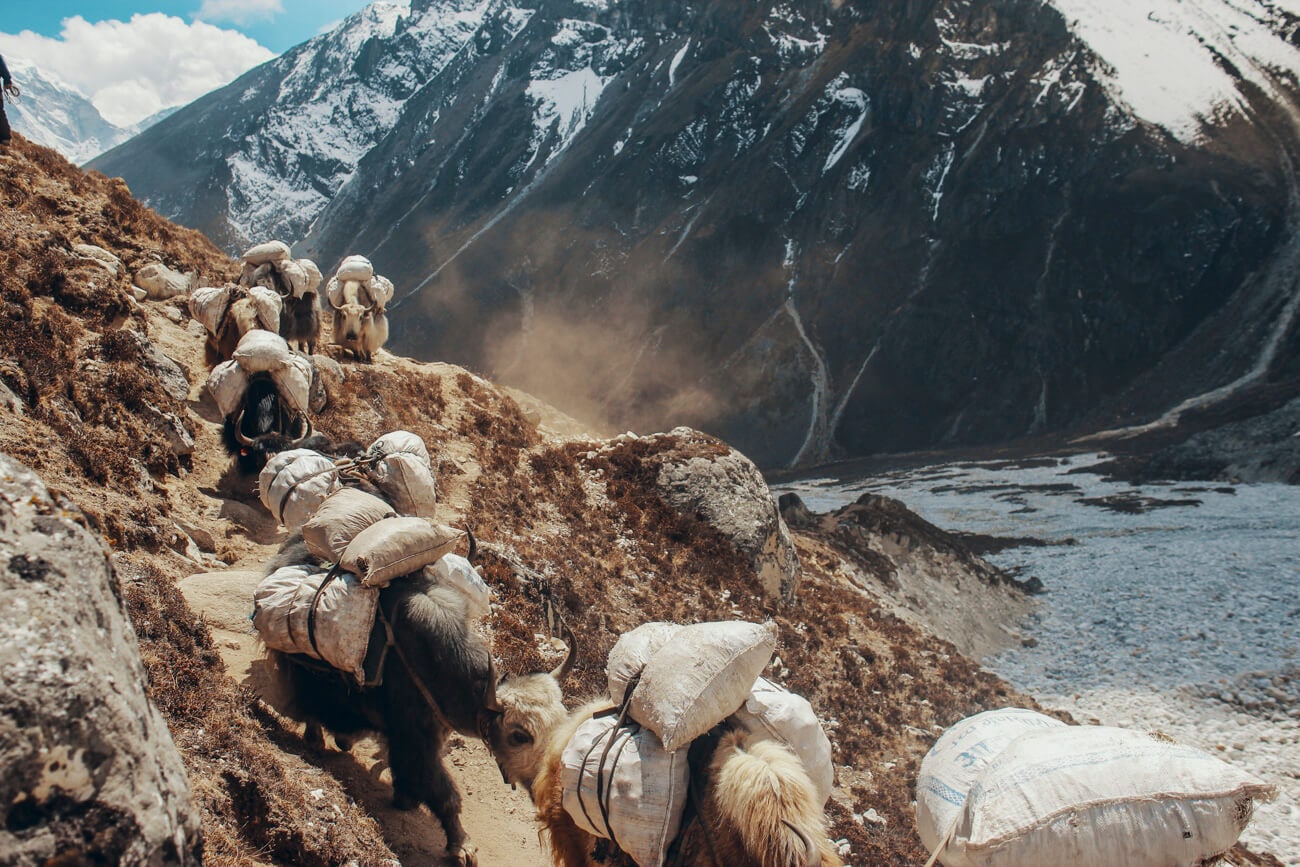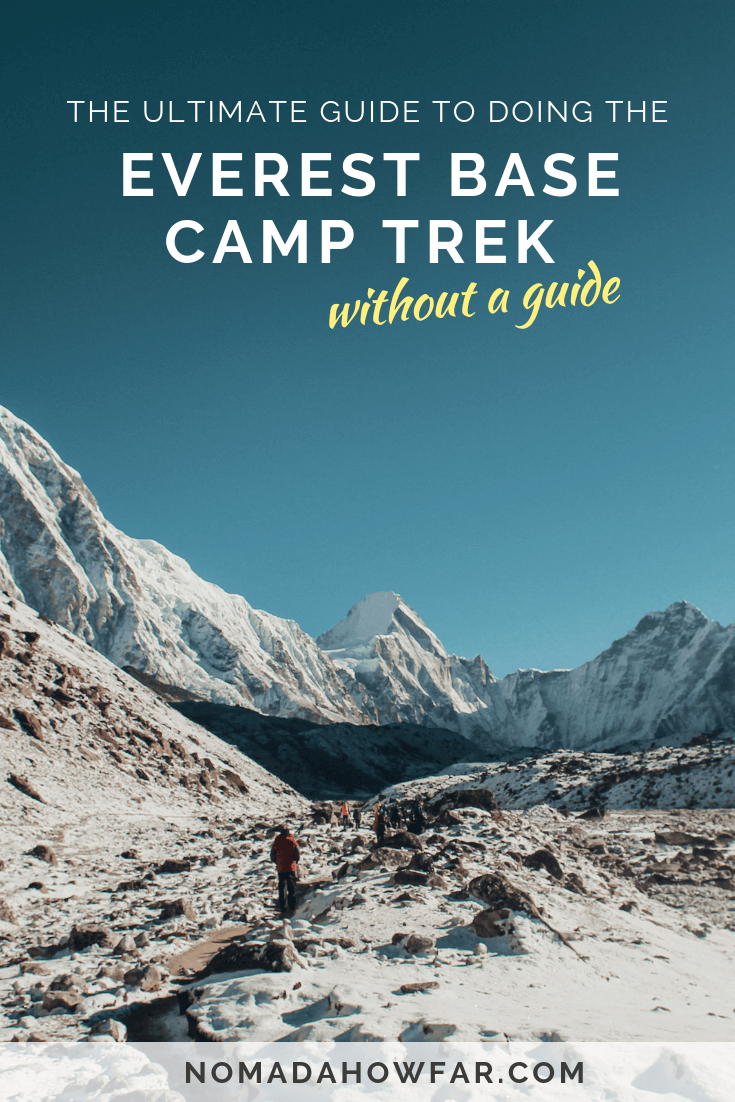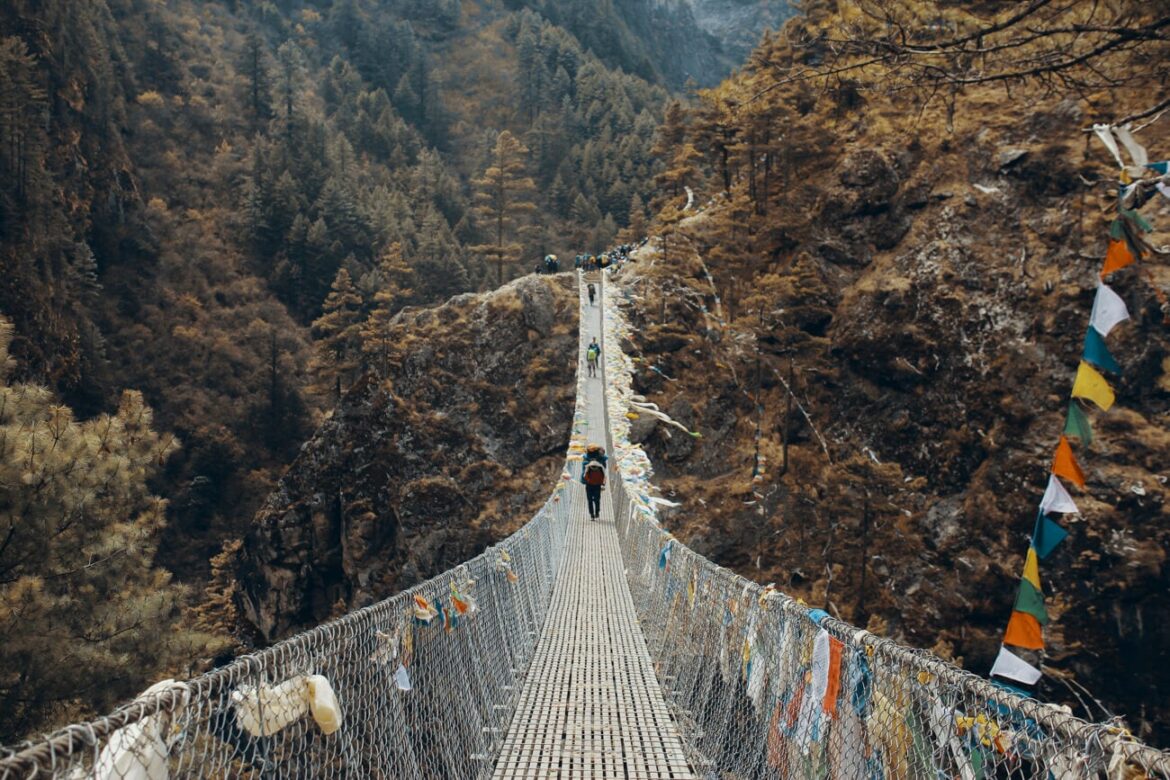The Everest Base Camp trek is possibly one of the world’s best-known hikes, but it’s also known as a really tough one. Most people that do this trek hire a guide and/or porter to support them during this 2-week trek. But having a guide is not necessary to make it to Everest Base Camp and back. Doing it on your own has plenty of benefits and isn’t hard to plan either. We’ll give you all the information you need to know to successfully complete the Everest Base Camp trek without a guide on an affordable way.
OUR STORY
The decision of going to Nepal to do the Everest Base Camp Trek was pretty much a spur-of-the-moment kind of thing. Our working-holiday visa for Australia was coming to an end and we didn’t have a plan yet of what was coming next. It was always one of Thomas’ dreams to go to the Himalayas and see these snow-capped giants from a close distance. We thought about it for a couple of days, because there was a big doubt if we could complete it successfully because Myrthe has asthma. We aren’t the most athletic persons either. You would rather call us couch potatoes.
Another reason why we were doubting of doing this trek was the cost of it. At first, when we searched the internet about the Everest Base Camp trek, we found information about guides, tours and such. These all started with the nice price tag of +- $1200/person. As we always prefer to explore places by ourselves, we didn’t really like the thought of not being able to do this trekking on our own pace.
‘There must be a way to do this without a tour’ we thought. And after some research, we found out that it’s perfectly possible to do it on your own, although it’s less popular. Most people think that it’s too dangerous to do the trek without a guide, but the path is actually not that hard, and it’s practically impossible to lose your way. Trekking to Everest Base Camp is 100% safe as long as you follow all the rules. We’ll talk about that later.
The decision was made. The flight from Melbourne to Kathmandu was booked and we started researching what we had to do, arrange, and what we could expect. We didn’t have prior experience with multiple day hikes, except for a five day trek in the Hardangervidda in Norway. We did the ‘most dangerous hike in the world’, and some long day hikes in Tasmania and SE Asia. But this would be a whole new adventure on a whole other level.

EVEREST BASE CAMP TREK WITH OR WITHOUT A GUIDE?
Everyone has his/her own goals and so their own personal reasons why they should take a guide or not. One of the factors, why we chose not to take a guide or porter, is that we wanted to succeed in this adventure entirely on our own. We wanted to carry our own bags up to the top. That’s why we chose to do the Everest Base Camp trek without a guide or porter as we had the feeling that doing everything on our own gave ourselves a bigger challenge. So completing it on our own strengths would give us a greater sense of proudness. Besides that, we could plan our own itinerary, lodges, pace and all this on a more affordable way.
Again, some people might not feel this need to do it all by themselves or just can’t do this because of physical reasons. Everyone can decide for themselves if they need a guide and/or porter. The trek is not a walk in the park, so everyone that does the trek deserves equal respect.
To be honest, having a guide has some advantages. They can book your lodges beforehand so you don’t have to worry about this, they motivate you on moments you have a lack of energy, and in most lodges, your food gets served prior to those who don’t have a guide (this frustrated us a lot of times!). But everything depends on the knowledge and quality of your guide. The cheaper ones won’t give you much information about the area unless you ask them about it, the more expensive ones will have more experience with guiding and will support you much more.

DO I NEED TO BE EXTREMELY FIT TO DO THE EVEREST BASE CAMP TREK?
This is a really tough question because every person is different. But to answer your question; no you don’t need to be incredibly fit to make it to Everest Base Camp! If you can walk multiple hours a day up and down hills, you should be able to make it. Even people that go to the gym every day will have a hard time at some point on the trek.
Your biggest concern should be altitude sickness, and to this day, nothing has ever proved that your fitness level has a factor on this. In fact, the slower you go, the more time you have to acclimatize to the high altitude. It often happens that people with a great fitness level or trekking experience go too fast and get sick too soon. Everyone is able to do the trek, but you need to have the will to make it to Base Camp.
However, we recommend beginning a training schedule a few weeks ahead of your trip to Nepal so you can prepare for the trek. We’ve tried to follow a running program, but eventually just went four times running and even we’ve made it. So we are sure you can do it too!
Unlike some people might think, you also don’t need any prior mountaineering experience. You just follow a walking trail along the mountains and through small villages. The trekking trail ends at Everest Base Camp. It’s here that the climbers set up camp, train and acclimatize to prepare themselves for their attempt to climb the summit.

HOW MUCH DOES IT COST TO DO THE EVEREST BASE CAMP TREK?
It entirely depends on your choices, but doing the trek independently cuts down the costs tremendously. Booking a tour costs you about $1200/person, while we did the whole trip with about $1500 for two. That means it cost us $750/person, flights in and out Lukla, trekking permits and ALL our trekking gear included. When you know that we’ve been 17 days in the Khumbu region, then that’s about $44/person a day. If you already have your trekking gear and want to walk in and out from Jiri, you can have all your meals and accommodation for $15/day! Well, that’s a bargain, especially on those heights.
Travel Tip:
Make sure to bring more than enough cash with you on the trek as there are only ATM’s in Namche, but these do not always work. Withdrawal fees in Kathmandu are ridiculously high, so we suggest to bring plenty of dollars and exchange that in Thamel to Nepali Rupee.
We had to buy all our trekking gear in Kathmandu because we don’t carry around a lot of warm clothing, nor trekking shoes, during our RTW-trip.
Our total price breakdown (prices are for two people):
- Trekking gear bought in Thamel: $255
- Flights in & out of Lukla: $640
- Trekking permits: $100
- Food: $475
- Accommodation: $15
- Miscellaneous (books & meds): $23
Total: $1508
As you can see, the cost of accommodation is pretty low. That’s because we arranged with most of the teahouse owners to have a room for free in exchange that we eat all our meals in their guesthouse. Most tea house owners will agree with this as this is the way how they make their money. Otherwise, most teahouses charge around $1-2 per night for a room. The higher you go, the more expensive it becomes. In Lobuche, every lodge asks the minimum of 500 rupees (+- $5) which you have to pay when entering the village. In Gorak Shep, we also paid 500 rupees for a night.
You can save a lot of money if you stick to local food like veg curry or dal bhat. They give you plenty of energy -ever heard the saying “Dal Bhat Power, 24 Hour”?- and are healthy and cheap! Beer is pretty expensive on the trek, so we just sticked with the good old black tea. If you’re planning to drink a couple of cups in an evening, take a pot as this will be cheaper.
Be aware that food becomes more expensive the higher you go. This is because the only way to get everything to the lodges is by yaks. It’s best not to take any meat on the mountain, how tempting it can be because the meat won’t be fresh anymore once it reaches the lodges. Buy some snacks (snickers, dried fruit, nuts) in Kathmandu before your trek. These things are super expensive on the trail.
Travel tip: If you take Dal Bhat, you can get a free refill in most lodges. It’s ok to ask for some more.

WHAT TREKKING GEAR DO I NEED?
This is a question that a lot of first-time trekkers in the Himalaya region ask themselves because it is so important not to overpack, especially if you’re trekking without a porter. We’ve made a list out of first-hand-experience about what you definitely need to bring with you on your Everest Base Camp trek.
WHEN’S THE BEST TIME FOR TREKKING IN NEPAL?
We did the trekking the second half of April, which is actually right in the middle of peak season when all the groups go up. When we went up, and especially on the first part between Lukla & Namche Bazar, the trail was full with trekkers. Because of this, the trail became congested on some places like narrow passes or at the suspension bridges. Once in Namche, the higher you go, the less crowded it becomes. But still, it’s almost impossible to lose your way here because of everyone around.
When we returned, it was very noticeable that much fewer people were crossing our path which made it much more enjoyable. So next time, we’ll try to go just on the shoulder of peak season.
Spring (April-May) and Autumn (October-November) are by far the most busiest seasons to trek to Everest Base Camp. But these seasons will almost definitely guarantee good weather, clear skies, and soft temperatures. Autumn offers a slightly better chance for good weather, while the only moment when you see tents and climbers at Base Camp is in Spring. We suggest going in the shoulder months (just before or after peak season). During these months you escape the crowds but still have a good chance of clear skies.

WHICH EVEREST BASE CAMP TREKKING PERMITS DO I NEED?
Most websites still state that you need two trekking permits during your trek to Everest Base Camp. These are the TIMS card (Trekkers Information Management System) and the Sagarmatha National Park Entry Permit which you pay on the trail in Monjo. Unfortunately, these websites are outdated now as they recently changed the rules a bit. Since a couple of months, you don’t need the TIMS permit anymore. You now just need to pay the Local Entry Permit in Lukla. THE TIMS PERMIT DOESN’T GET CHECKED ANYMORE. It’s still available at the Tourism Board in Kathmandu but getting this would just be a waste of money.
From now on, you don’t need to arrange anything before your trek as all the permits need to be paid on the trail. The first permit you have to pay is the Local Entry Permit in Lukla, just before you leave the village. This permit costs Rs 2000 per person ($20). They introduced this permit because the local authorities were not happy that most of the money from TIMS permit never got to Lukla to support the locals and the trail.
The second permit you need to pay for is the Sagarmatha National Park Entry Permit in Monjo. This permit costs Rs 3390 per person ($30). They’ll check this permit later on the trail when entering Namche Bazar and on your return in Tengboche.

DO I NEED TRAVEL INSURANCE FOR THE EVEREST BASE CAMP TREK?
Definitely yes! You never know what might happen with you on the trail. In most cases, you can just abort the trek and hike back to Lukla where you can hop on the plane to Kathmandu. But when you hike on such high altitudes, expect the best but be prepared for the worst. You never know if you get severe altitude sickness or sprain your ankle. It happens with the best, and mostly on times you don’t want it to happen.
If you already have travel insurance, better check if you’re covered for emergency helicopter evacuations on extreme heights. Most insurances won’t cover this on their basic coverage. If you need to use a helicopter evacuation (let’s hope not) and you can’t provide evidence that your travel insurance covers this, you’ll have to pay at least $5000 for the helicopter, even before they come and rescue you. After that, your medical expenses can almost double that amount!
We highly recommend taking your travel insurance with True Traveller.
We already use their travel insurance for two years and are super happy with it. Their customer service is excellent, and they’ve always helped us well during our travels. It’s also very affordable and easy to get travel insurance with them, even if you’re already backpacking. Not many insurance companies provide this service if you’re already traveling. You can get a special trekking insurance with them which will cover you for everything. Or you can get the Backpacker Insurance with the Extreme Adventure Pack to get you covered for this kind of adventure. Get a quote here.

HOW CAN I AVOID ALTITUDE SICKNESS (AMS)?
When you do the Everest Base Camp Trek, you’ll trek through the two altitude zones high altitude (2,500 – 3,500m) and very high altitude (3,500 – 5,000). When you’re trekking in such high regions, you’re definitely prone to get AMS or Acute Mountain Sickness or even HAPE or HACE which are more severe than standard altitude sickness. Everyone that isn’t used of living their whole life in one of these high altitude zones has the chance of getting AMS. Even experienced climbers or even when you didn’t have it the last time you were on such heights.
The number one reason of getting Acute Mountain Sickness is because your body isn’t acclimatized enough to the much thinner air on these high altitudes. So it is essential to GO SLOW from the moment you’re in Lukla as Lukla is already on 2,600m. Give your body plenty of time to acclimatize. If you’re a fast walker, it will probably be a bit awkward or frustrating to go slow but know that it’s for your own good!
Tips to avoid altitude sickness:
- Go slowly
- Drink a lot of water to prevent dehydration
- Avoid smoking and alcohol until you’re going back down (best to wait until Namche)
- Plan plenty of acclimatization days in your itinerary
- Be flexible in the itinerary in case you need to acclimatize some extra days
- Garlic soup can help against light symptoms
- Try to apply the rule of ‘trek high, sleep low’. Trek a couple of hundred meters higher each day than you’ll sleep, to make your body is used to the height.
- Take some Diamox with you
The general rule during high altitude trekking is that if you get symptoms like a headache, nausea, dizziness and extreme shortness of breath, it’s most likely AMS. In this case, whatever you do, do not ascend further! Stay on that height or descend and rest for 1-2 days until the symptoms go away. Only then you may resume the trek. If the symptoms stay, descend more.
If you need medical advice, there are aid-posts in Namche, Khunde, Pheriche and at Everest Base Camp. They can provide with medical assistance and help you in case of sickness although these medical posts are very basic and small. The one in Pheriche and EBC are led by volunteering western doctors. You can attend a free talk about Acute Mountain Sickness and all its stages every day at 3 PM in Pheriche.

WHAT’S THE BEST ITINERARY FOR THE EVEREST BASE CAMP TREK?
Most itineraries to get to EBC and back will take from 12 to 14 days. A lot of them are all the same, especially if you look at the itineraries of tours & guides. Everyone is following the same route after all. But it’s worth to go a little bit of the well-trodden path and go through smaller villages as well. We compiled our own itinerary for your convenience and have written down our teahouse and lodge recommendations for each stop. This can be super handy if you don’t want to search for a good guesthouse after a whole day walking! We recommend to start with a basic itinerary and adjust it to your own preferences. Only then it will become the best itinerary for the Everest Base Camp Trek.
FLYING IN OR WALKING IN?
Walking in will be much cheaper than flying in and out but then you’ll miss out of landing on the world’s craziest airport! We’ve dedicated a full blog post about flying into Lukla and its alternatives.
Related articles you might like:
- Everything You Need To Know About Flying To Lukla
- The Best Everest Base Camp Trek Itinerary For Independent Trekkers + Teahouse Recommendations
- Essential Trekking Gear For Your Next Trekking In Nepal – The Complete Packing List
Interested in our travels and adventures? Follow us on Facebook, Twitter and Instagram for (almost) daily updates!
Pin this for later




4 comments
Loved this post! I trekked ebc last year but with a guide. I admire you both for trekking without a guide, I definitely needed one. Then again, i’d never trekked before or been on a mountain. I found it incredibly hard. What was your favourite part about your trek?
Of course our favourite part was when the last stretch towards Base Camp. We were so happy that we made it without problems and it felt like a great success. The trail between Lobuche and Gorak Shep is just stunning when you’re walking in between those giant snowcapped mountains! We want to go back as soon as possible ?
Hello, thank you for all this great information.
Me and my girlfriend are heading to do EBC mid April. I’m wondering if there were ever times.there was no accommodation?
Also is the path straight forward?
thank you very much!
We never had a problem actually. Up to Lobuche there are plenty of teahouses to choose from. Just for the last stretch, we left at dawn too make sure we got a room in Gorak Shep. There are only 2 teahouses which fill up very quickly in high season. The path is very clear. You won’t have any problems with finding your way.